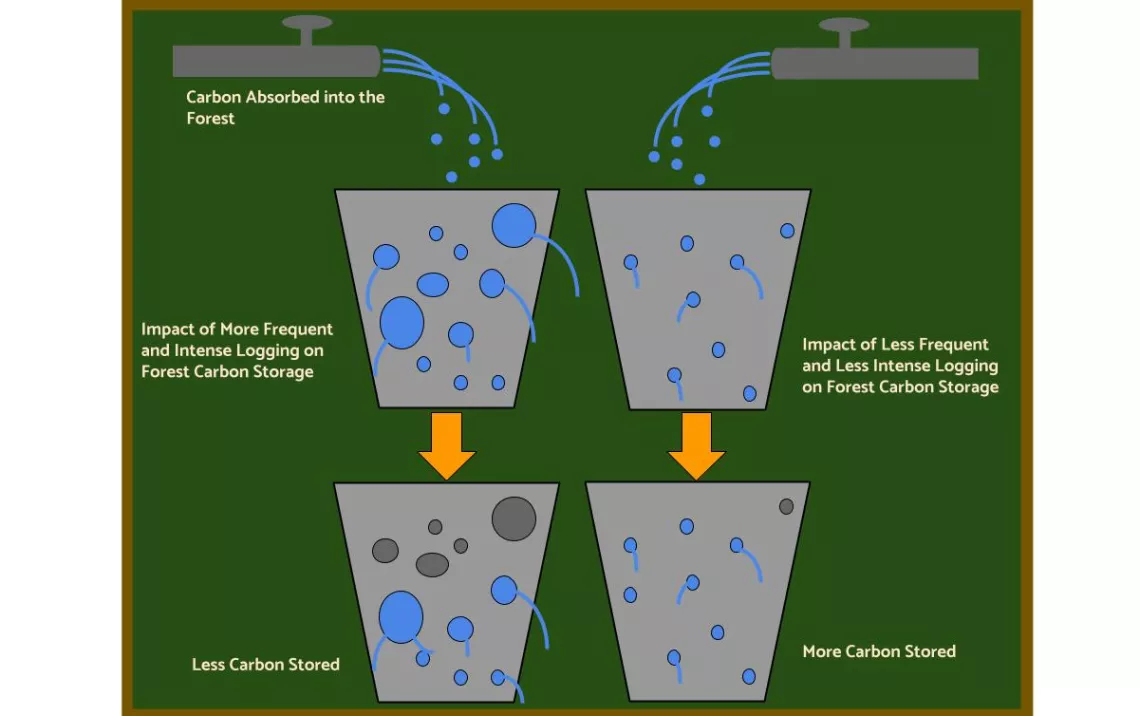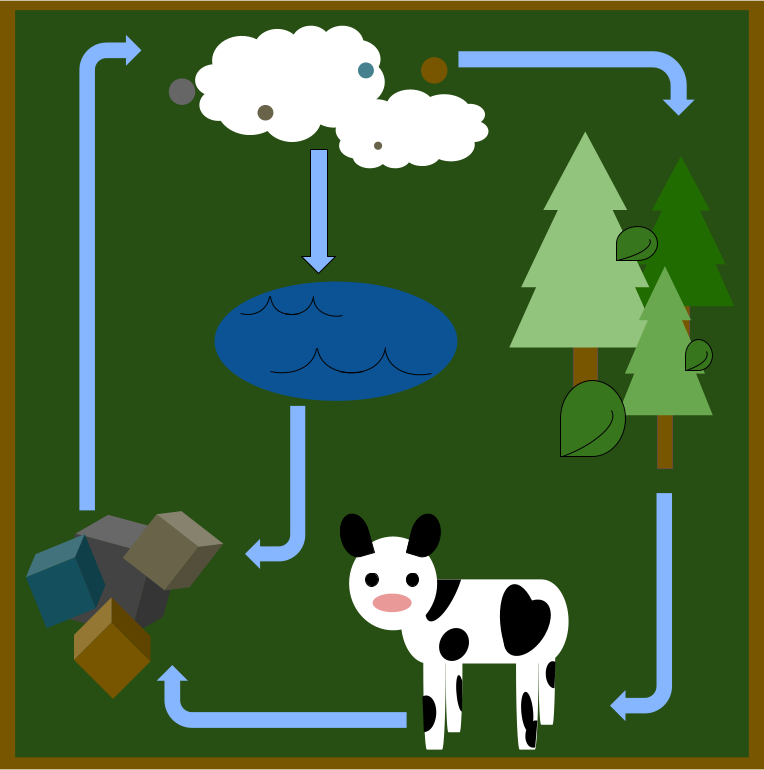Carbon Storage vs. Carbon Sequestration
First, in order to dive into carbon storage, let’s clarify the difference between carbon storage and carbon sequestration.
By definition, carbon storage is the total amount of carbon stored in forests, trees, soil, or other parts of the forest.
Carbon sequestration, on the other hand, is the process of taking carbon from the atmosphere and transporting it to a location where it will not be immediately released, such as soil or a tree’s biomass.
Why is Carbon Storage in Forests Important?
Carbon dioxide traps heat in Earth’s atmosphere (a process called the Greenhouse Effect), causing global temperatures to rise. Protecting carbon stores and finding ways to store additional carbon is, therefore, crucial to mitigate the impacts of climate change. Trees are the Earth’s natural defense against the Greenhouse Effect. They absorb carbon dioxide, store it, and then release oxygen back into the atmosphere.[1] Over a tree’s lifespan, the amount of carbon stored in a tree grows, and if a tree dies from logging or other means, carbon is released back into the atmosphere. The bigger trees store larger amounts of carbon, so if a bigger tree dies, more carbon is released.
As the amount of carbon humans emit increases year by year (a trend that must be reversed immediately), the need for more carbon storage is vital if we want to maintain the health of our planet! The Greenhouse Effect becomes more and more startling as we lose trees, resulting in less storage space for the increasing amount of carbon.
Image Courtesy of Ashish Gupta
Carbon and Old Growth Forests
Old growth forests are complex ecosystems with stands of trees that have been around for a very long time, typically characterized by their large size, thicker barks, and limited interactions with human activities. These trees take in the vast majority of our forests’ carbon due to their size, making them extremely necessary in the effort to mitigate emissions. The largest one percent of trees take in 50% of the above-ground carbon stored in the entire world.[2] Clearly, the ability of these trees is incredible and a huge benefit in the fight against climate change
The Leaky (Carbon) Bucket

Graphic courtesy of Maureen Louie
The Leaky Bucket Analogy is a way to illustrate how much carbon a forest can store depending on a multitude of factors. The faucet represents the forest’s constant absorption of carbon from the atmosphere, and the bucket represents a forest’s capacity to store carbon. The bucket’s size depends on how old the forest is.[3]
If a forest is characterized as mature or old growth, the bucket is big and lots of carbon is stored. If the forest is younger, the bucket is smaller and less carbon can be stored.[3] Holes in the bucket naturally occur as plants and animals die and release carbon into the atmosphere.
However, the amount of carbon lost by these natural producers is offset by the intake of carbon from the atmosphere (the faucet).[3] The death of these plants and animals also aids forest health as the natural passing of these organisms is essential for balance in the forest. The nutrient-rich organic matter becomes the soil for new generations. That said, when organisms die off due to human activities, such as logging, the number and size of the bucket’s holes increases at an unnatural and unsustainable rate.[3]
Depending on the frequency of the harvests, the number of holes will increase to varying degrees. In shorter rotations of harvesting, the forests are logged more frequently, resulting in lots of released carbon and little stored. Also, the size of the holes increases when harvests are more intense, as in clearcutting (every tree harvested from an area). Short rotations paired with clearcutting is a recipe for greatly reduced carbon storage capability in a forest. Although replanting after harvesting definitely ‘plugs holes’ and increases ‘water levels’ in the bucket, newer trees do not take in nearly the same amount of carbon as old growth trees do.
It’s important to understand that the size of the ‘holes’ greatly changes over time according to other factors. For instance, when a tree is burned, a small amount of carbon is quickly released from twigs and needles. The majority of the carbon (if the tree is left standing upright as a ‘snag’ tree) remains in the trunk of the tree, releasing very slowly. This is very different from logged trees (no longer standing) that only store a minuscule amount of carbon in comparison after they are felled.
Can Carbon Be Stored in Wood Products?
A very small amount of carbon can be stored in wood products, but compared to a living tree… there is no comparison. Harvested timber loses up to 85% of the total carbon it once stored![4] Let’s break this process down. 46% of a tree’s stored carbon is lost during the logging process.[4] Then, 22% is lost during the milling process, leaving the wood with 32% of its original stored carbon.[4] The final step is transportation, where around 17% is lost. The result? As little as 15% of the original carbon is stored in the final product.[4] Obviously, this is just a fraction of what could have been stored if the tree remained untouched.
Our lifestyles of overconsumption need a reality check. It’s crucial for us to understand how many resources we are wasting and how much we consume. If we were simply more conscious about our decisions, the amount of carbon we could leave stored in trees is untold. Try to visualize all the carbon lost for a product so fickle as a paper napkin, or any other single-use item. The costs far outweigh the benefits, and we must never lose sight of that fact.
The Carbon Cycle
The carbon cycle is arguably the most important way our planet maintains its health. In fact, carbon makes up 18% of all living matter![5] Let’s start with plants: plants take in carbon dioxide from the atmosphere during the process of photosynthesis. The result of photosynthesis is sugar (which is partially made of carbon) and oxygen. Animals (including humans) then consume plants, transferring the carbon in the plants to the animals. Carbon is also transferred through respiration, or breathing. When we inhale, we take in oxygen, and when we exhale, we release carbon dioxide back into the atmosphere. The ocean can also be a source of carbon dioxide, depending on the temperature of the water. Cooler water around the North and South poles absorbs carbon from the atmosphere, while warmer water in the tropics releases carbon back into the atmosphere. In addition, carbon is stored for millions of years in sediments in the ground, creating what we know today as fossil fuels.
Graphic Courtesy of Maureen Louie
Fossil fuels were never supposed to be included in the carbon cycle. However, the carbon humans release into the atmosphere by burning them is now impacting the natural cycle. By burning materials like coal, oil, and natural gas, large amounts of carbon are released into the atmosphere. Oceans are now burdened with so much carbon that they're slowly acidifying, killing a wide variety of organisms in doing so. Plants’ vital nutrient levels are lowered when they take in too much carbon.[6]
[1] "What is carbon sequestration?" Frequently Asked Questions, United States Geological Survey, www.usgs.gov/faqs/what-carbon-sequestration. Accessed 14 July 2022
[2] "6 reasons old-growth forests are really important." The Wilderness Society, 12 May 2022, wilderness.org/articles/blog/6-reasons-old-growth-forests-are-really-important.
[3] "How Forest Carbon Works: The Leaky Bucket Analogy." Sierra Club, www.sierraclub.org/forests/how-forest-carbon-works-leaky-bucket-analogy. Accessed 23 Aug. 2022.
[4] "What happens to carbon when trees are cut?" Green Oregon, www.greenoregon.org/climate-resilience/. Accessed 23 Aug. 2022.
[5] "Carbon Cycle Process." Youtube, uploaded by Learning Junction, 15 June 2021, www.youtube.com/watch?v=p3R-dB9K4ss.
[6] "The Effects Of Too Much CO2 In A Grow Room" Atlas Scientific, 16 July 2021, www.atlas-scientific.com/blog/effects-of-too-much-co2-in-grow-room/.
Learn More!
Logging Fungal Networks Biodiversity Climate Change Solutions & News Connections
